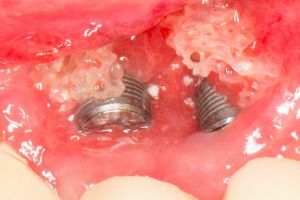 In dental practice, dental implantation is a fairly popular and common method that allows you to restore a lost tooth or several, or completely the jaw. This type of prosthetics is possible for almost any age category.
In dental practice, dental implantation is a fairly popular and common method that allows you to restore a lost tooth or several, or completely the jaw. This type of prosthetics is possible for almost any age category.
But, cases where implantation leads to certain complications are not ruled out. One of them is periimplantitis. According to studies, this disease occurs in 16 percent of patients.
Peri-implantitis is a process of inflammation accompanied by soft tissue damage that is located around the implant. In this phenomenon, the probability is not ruled out that bone tissue will also break down. At first, its structure is thinned, then its amount decreases in the area of the lesion, ultimately, the implant is rejected.
The development of infection is possible both in the shortest time after implantation, and in months or years.
Contents
- Causes of development
- Causes of development
- Clinical picture
- Classification and flow stages
- Diagnostic methods and tests
- Assisting
- Surgical method
- Consequences of
Causes of development of
A number of reasons contribute to the development of the inflammatory process, among the main ones distinguish the patient's own fault and medical errors.
To the wrong actions on the part of the doctor are:
- hit in the saliva of the patient, which consists of microorganisms that can trigger the onset of the infection process;
- low quality of the installed product;
- insufficient cooling or, conversely, excessive heating of bone tissue, which immediately provokes necrosis, against this background there is no integration of the implant;
- non-observance by the doctor of sanitary norms;
- penetration into the implant of cement mortar from the crown;
- trauma and hematoma in the course of operative actions and development of hematomas, which subsequently fester;
- improper parameters of the prosthesis, as a result of which it is installed past the bone, with which, in fact, the fusion should occur.
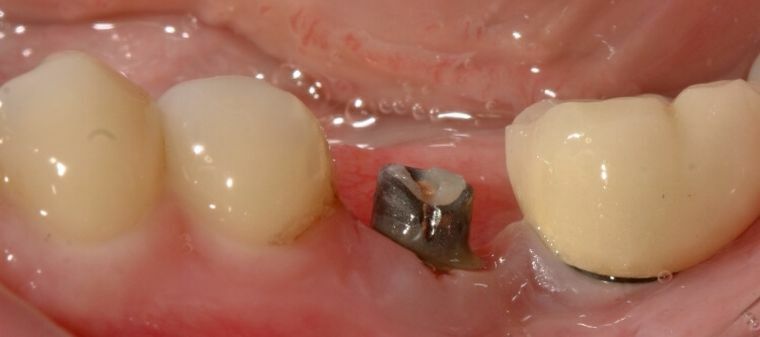
Reasons for rejection due to the patient's actions:
- neglect of the rules of oral hygiene;
- excessive load on the artificial tooth;
- non-compliance with medical recommendations for rapid and proper healing, which leads to inflammatory processes;
- neglect of mandatory examinations, which after installation of non-removable implants should be conducted up to several times a year.
In addition, poor quality preoperative examination can also provoke pathology, as a result of which there were no reasons that are a contraindication to the prosthesis:
- diabetes mellitus;
- various infections;
- alcoholism;
- malignant tumor formation;
- decrease in the immune system;
- excessive smoking;
- allergic reactions to titanium.
Clinical picture of
This disorder is often confused with other pathologies of soft tissues surrounding the tooth, but peri-implantitis accompanies the characteristic symptoms:
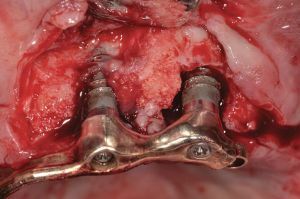
In the photo, implant rejection, inflammation and bleeding due to peri-implantitis of stage 4
- gum bleeding;
- is an inflammatory process;
- suppuration;
- mobility of the prosthesis;
- swelling of the tissues near the artificial tooth and redness;
- pain syndrome;
- thinning of the connective bone;
- looseness of the gums, increasing its depth.
Classification and flow stages
Peri-implantitis has three forms:
- early - rejection is observed already within the first month after the prosthesis;
- average - after 3-6 months or one to two years;
- late - problems associated with artificial teeth, begin to appear only after a couple of years, the culprit in this case is only the patient himself.
Stages of development:
- First .It is accompanied by thinning of the bone tissue, desiccation of the gums. The mobility of the prosthesis is observed, the surrounding tissues begin to bleed and acquire a red shade. Bone remains normal.
- Second .With untimely begun therapy, deformation of the bone, looseness, gum exfoliation, an increase in the depth of the pockets continues. In addition, tooth resistance is lost.
- Third .From any, even insignificant, touch, severe pain begins to manifest. Mobility becomes permanent.
- Fourth .There is a complete destruction of the alveolar process. Inflammation is accompanied by pain and poor health.
Diagnostic methods and tests
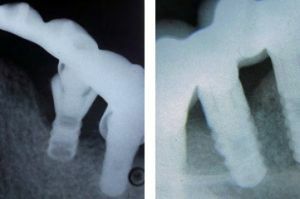 Diagnosis is performed by visual and instrumental examination of the oral cavity. In the presence of the disease, the dentist can see edema and flushing, When probing the gums, there is increased bleeding.
Diagnosis is performed by visual and instrumental examination of the oral cavity. In the presence of the disease, the dentist can see edema and flushing, When probing the gums, there is increased bleeding.
Thanks to palpation, purulent contents are established. In addition, the mobility of the prosthesis is clearly visible.
The clinical diagnostic methods include:
- Müllmann-Cowell index - determines the intensity of bleeding;
- Schiller-Pisarev test - is the staining of glycogen gums, with the available inflammatory processes, there is an increase in its number;
- PMA index - examines the initial changes;
- test by Fedorov-Volodkina;
- Russon periodontal index - determines the stage of inflammation, the stability of the prosthesis, the depth of the pocket.
To determine the degree of destruction of bone tissue use:
- orthopantomography;
- computed tomography;
- X-ray.
Additionally, other diagnostic tests can be used: biochemical, polymerase chain reaction and others.
Assisting
Treatment of peri-implantitis is carried out in two main ways: conservative and surgical.
Conservative treatment is ineffective, as it can lead to relapse, since elimination of the gum line does not occur. With this method of treatment, the following measures are carried out:
- removal of the pain syndrome, antibiotics may be taken;
- is anesthetized;
- cleaning and rinsing of the crown;
- granulation removal;
- procedures for sanitizing the entire structure;
- collection and installation of a processed implant.
Surgical method
Only after conservative treatment is performed, an operative method of therapy is applied, which includes several procedures:
- oral cavity is prepared by cleaning, disinfection, sanitation;
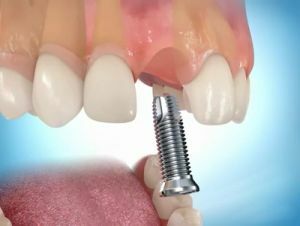
- after the introduction of anesthesia open problem channels and clean them;
- design is processed by chemical and mechanical methods, for this use hydrogen peroxide, citric acid, tetracycline;
- , depending on the degree of development of pathology, provides restoration therapy;
- appointment of further treatment( rinsing, taking medications).
Depending on the stage of the disease, the stages of surgical intervention will have their own peculiarities.
Therapy of the first and second stage of the disease is as follows:
- prepare the oral cavity;
- produce a gum incision;
- remove stubs and granulations;
- do the cleaning of the bed and prosthesis;
- with the help of mills correct the bed of bone;
- installs stubs;
- sutures and conducts hemostasis;
- for further therapy appoint antiseptics, antibiotics and antihistamines.
After these procedures, the inflammatory process is removed after 7-14 days.
If the pathology has a third or fourth stage, then the restoration of the affected bone is performed. In this case, the order of work will be to perform the following actions:
- first prepare the oral cavity;
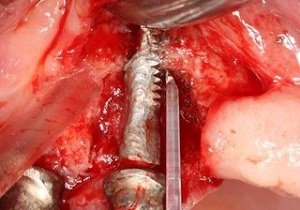
- cuts and flakes the flap of the alveolar process;
- performs trepanation of the cortical plate;
- removes the implant;
- clean and sanitize the bed;
- level the prosthetic surface;
- performs implantoplasty;
- isolate the affected area;
- apply seams;
- prescribe anti-inflammatory drugs;
- do reimplantation.
With a two-stage implantation option, the prosthesis can be installed after a month.
Consequences of
As a rule, once-implanted implants are subjected to secondary rejection even with effective and qualitative treatment.
In most cases, recurrent peri-implantitis is caused by mistakes made by doctors during the operation. With an initially incorrect root, eliminating inflammation only relieves the symptoms, the very same reason remains unaffected.
Because of this, the risk of relapse is increasing until the design is surveyed. In case of rejection, which is not connected with conducting an operative intervention, a positive prognosis of treatment is observed.
